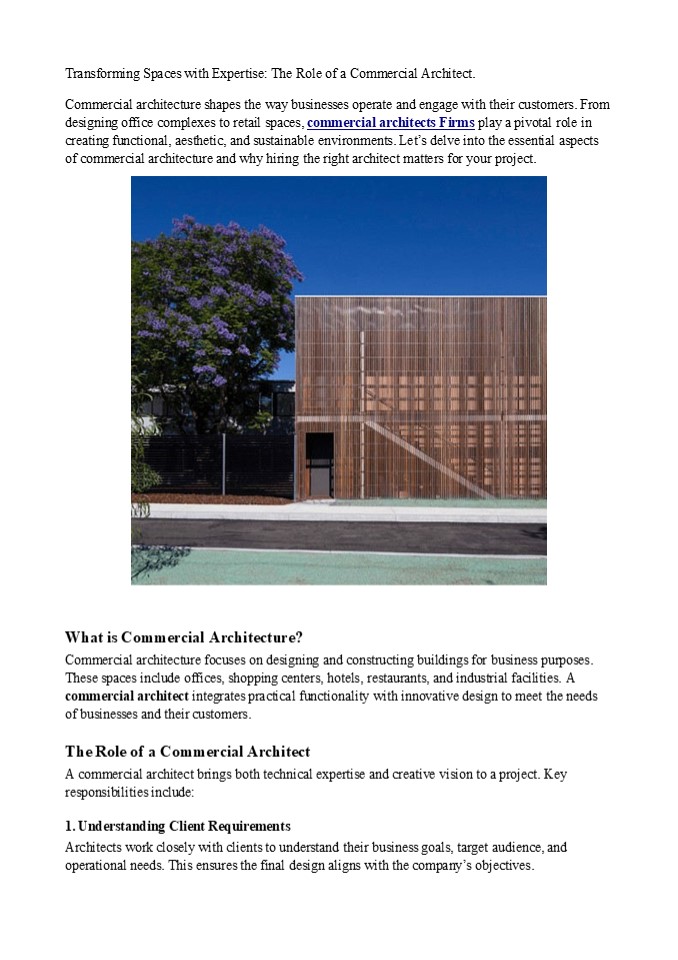Commercial Architect - PowerPoint PPT Presentation
Title:
Commercial Architect
Description:
Our approach to commercial architecture is grounded in understanding market dynamics, customer behaviour, and the specific needs of each business. With Peter Vernon Architects, you’re not just getting a design; you’re getting a strategic business asset. Our reputation in commercial architecture is based on our designs, planning and crafting spaces that businesses can truly call their own. – PowerPoint PPT presentation
Number of Views:2
Title: Commercial Architect
1
Transforming Spaces with Expertise The Role of a
Commercial Architect. Commercial architecture
shapes the way businesses operate and engage with
their customers. From designing office complexes
to retail spaces, commercial architects Firms
play a pivotal role in creating functional,
aesthetic, and sustainable environments. Lets
delve into the essential aspects of commercial
architecture and why hiring the right architect
matters for your project.
What is Commercial Architecture? Commercial
architecture focuses on designing and
constructing buildings for business purposes.
These spaces include offices, shopping centers,
hotels, restaurants, and industrial facilities. A
commercial architect integrates practical
functionality with innovative design to meet the
needs of businesses and their customers. The
Role of a Commercial Architect A commercial
architect brings both technical expertise and
creative vision to a project. Key
responsibilities include 1. Understanding
Client Requirements Architects work closely with
clients to understand their business goals,
target audience, and operational needs. This
ensures the final design aligns with the
companys objectives.
2
- Conceptualizing and Designing Spaces
- Using advanced tools and software, architects
create detailed designs that are visually
appealing and highly functional. - Navigating Building Codes and Regulations
- Commercial architects ensure designs comply with
local regulations and zoning laws, reducing the
risk of legal issues. - Project Management
- From planning to construction, architects oversee
the entire process, ensuring the project stays on
track and within budget. - Key Elements of Commercial Architecture
- Functionality
- The design must cater to the specific needs of
the business, such as efficient workflows,
customer convenience, and optimal use of space. - Aesthetic Appeal
- Modern commercial spaces are designed to make a
statement. An attractive environment can enhance
a brands image and create a positive impression
on customers. - Sustainability
- Sustainable practices, like using
energy-efficient materials and integrating
natural lighting, are becoming standard in
commercial architecture.
3
- 4. Increased Property Value
- A professionally designed building adds long-term
value to your property, making it a worthwhile
investment. - Trends in Commercial Architecture
- Smart Technology Integration
- From automated lighting systems to energy-saving
HVAC solutions, commercial spaces are
increasingly leveraging technology for efficiency
and comfort. - Biophilic Design
- Incorporating natural elements like greenery and
open spaces creates a relaxing and productive
environment. - Adaptive Reuse
- Converting old structures into modern commercial
spaces is a sustainable and cost-effective trend
gaining popularity. - Choosing the Right Commercial Architect
- Experience and Portfolio
- Look for architects with a proven track record in
designing commercial spaces similar to your
requirements. - Innovative Approach
- Choose an architect who brings creative solutions
to the table, balancing functionality with design
innovation.































